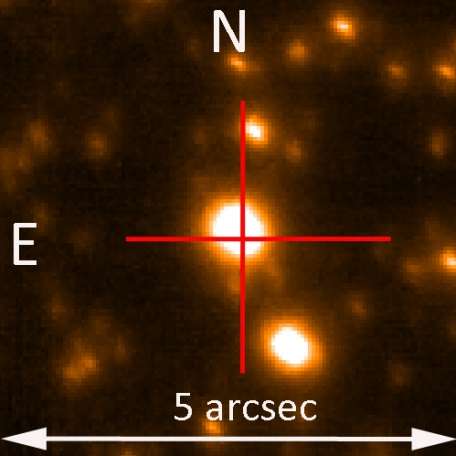April 11, 2017 report
Astronomers discover new substellar companion using microlensing

(Phys.org)—Using a gravitational microlensing technique, astronomers have detected a substellar companion of a host star in the system designated MOA-2012-BLG-006L. The new object is assumed to be a high-mass giant planet or a low-mass brown dwarf. The findings were presented in a paper published April 4 on the arXiv pre-print server.
Based on the gravitational lens effect, the microlensing method is mainly used to detect planetary and stellar-mass objects regardless of the light they emit. This technique is therefore sensitive to the mass of the objects, rather than their luminosity, which allows astronomers to study objects that emit little or no light at all.
The discovery of the microlensing event MOA-2012-BLG-006 was announced by the Microlensing Observations in Astrophysics (MOA) group on February 9, 2012. A few days later, the event was also detected by the Optical Gravitational Lensing Experiment (OGLE) and designated OGLE-2012-BLG-0022. Further observations of this event revealed the signal indicating the presence of a binary system, which was labeled MOA-2012-BLG-006L or OGLE-2012-BLG-0022L.
The latest analysis of the available observational data of MOA-2012-BLG-006L provided by the 1.3m telescope at Las Campanas Observatory in Chile, the 1.8m telescope at Mt. John Observatory in New Zealand and the Keck-II telescope in Hawaii gives more hints on the properties of the system's components. A team of researchers led by Radosław Poleski of the Warsaw University Observatory in Poland has recently presented new results indicating that the substellar companion in MOA-2012-BLG-006L is a massive giant planet or a brown dwarf.
"We present the discovery of a substellar companion to the primary host lens in the microlensing event MOA-2012-BLG-006," the scientists wrote in the paper.
According to the study, the substellar companion, designated MOA-2012-BLG-006Lb, is an object about 8.4 times more massive than Jupiter, while its host has approximately half the mass of the sun. The system's mass ratio is above 0.01, while the projected separation is about 10.2 AU.
Although the mass of MOA-2012-BLG-006Lb is most likely below 10 Jupiter masses, the researchers do not exclude the possibility that it could be more massive, reaching up to 13 Jupiter masses. This depends on the exact mass of the primary star. This is the commonly assumed lower mass limit of a brown dwarf; therefore, the object could be a low-mass brown dwarf, as well.
"We presented a discovery of MOA-2012-BLG-006Lb – an object a few times more massive than Jupiter, which can be classified based on its mass either as a planet (most probable scenario) or a brown dwarf (if its mass is at the high end of the derived distribution). (…) The mass ratio is above 0.01, i.e., higher than typical mass ratio of a protoplanetary disc to the parent star. Hence, the lower mass object could have formed independently, and thus resembles brown dwarfs even if its mass is smaller than the commonly assumed boundary of 13 MJ," the paper reads.
The researchers concluded that their discovery could help to understand the mechanisms responsible for the formation of such objects as MOA-2012-BLG-006Lb, as they seem to operate similarly in the immediate solar neighborhood and in more distant parts of the Milky Way galaxy where only the microlensing method is able to detect them.
More information: A companion on the planet/brown dwarf mass boundary on a wide orbit discovered by gravitational microlensing, arXiv:1704.01121 [astro-ph.EP] arxiv.org/abs/1704.01121
Abstract
We present the discovery of a substellar companion to the primary host lens in the microlensing event MOA-2012-BLG-006. The companion-to-host mass ratio is 0.016, corresponding to a companion mass of ≈8 MJup(M∗/0.5M⊙). Thus, the companion is either a high-mass giant planet or a low-mass brown dwarf, depending on the mass of the primary M∗. The companion signal was separated from the peak of the primary event by a time that was as much as four times longer than the event timescale. We therefore infer a relatively large projected separation of the companion from its host of ≈10 a.u.(M∗/0.5M⊙)1/2 for a wide range (3-7 kpc) of host star distances from the Earth. We also challenge a previous claim of a planetary companion to the lens star in microlensing event OGLE-2002-BLG-045.
© 2017 Phys.org





















